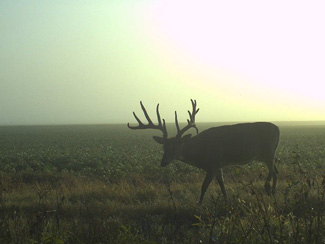Shape and size of food plots for deer
Shape of food plots for deer
 For example, let’s say a property has a 20-acre alfalfa field and 40 acres of woods. A good approach might be to set aside a 5-acre inside corner of the field for a food plot consisting of a either a single-grain crop or combination of grains.
For example, let’s say a property has a 20-acre alfalfa field and 40 acres of woods. A good approach might be to set aside a 5-acre inside corner of the field for a food plot consisting of a either a single-grain crop or combination of grains.
When planting grains for deer, I always double plant, running the grain drill back over the field between the rows previously planted. Although a 200 percent yield isn’t attainable, a 150 percent to 170 percent yield is common.
In the example, the 5-acre field now yields the same as if I’d planted an 8- acre plot. Between the grain and alfalfa planted in the 20-acre field, we now have a good draw from spring on through winter. This will be a big help in providing deer the nutrition they need throughout the year.
Next, by backing off the corner plot between 50 and 100 yards, we can add a ½- to 1-acre hunting plot. Though a dozer would be nice, chainsaws would work. Remember, we are doing this for deer, not cash cropping. A few stumps is no big deal.
Shaping this plot like a horseshoe or L provides several advantages. First, making it longer, yet keeping the width at no more than 40 yards wide, provides deer with an illusion of safety. One jump, and they’re back in the cover. This makes it much more likely that mature bucks will enter the plot before dark.
Also, bucks want to see the entire food plot. To do so, they must go to the apex of the plot. That makes stands on the outer and inner edges of the apex great producers. The plot’s shape and good stand placement results in nearly every mature buck offering a shot opportunity.
Another trick is to use the larger food plots to keep deer on your properties.
“The mistake most people make when putting in larger food plots is that they design them so a buck can check the entire field with one look,” says Tony LaPratt, owner and founder of Ultimate Land Management (www. tonysulm.com).
“Keeping the bucks on your land during shooting hours is critical. Most hunters don’t realize that you can do that during the rut. That’s time management for bucks,” LaPratt said. “Divide those food plots larger than a half-acre in size into blocks that can’t all be seen at once. The buck has to invest more than one glance to check them all. You can do this by taking that 4-acre food plot and using strips of corn to break it up into eight halfacre plots. Now, the buck has to check and mark each one before he jumps the fence to the neighbor’s fields. You just took that glance and turned it into a real time consumer. When you pair that with carefully designing bedding areas for both bucks and does on a property, they now leave after dark and are back before daybreak.”

